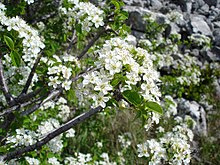|
Prunus mahaleb
Prunus mahaleb, the mahaleb cherry[6] or St Lucie cherry, is a species of cherry tree. The tree is cultivated for a spice obtained from the seeds inside the cherry stones. The seeds have a fragrant smell and have a taste comparable to bitter almonds with cherry notes. The tree is native to central and southern Europe, Iran and parts of central Asia. It is adjudged to be native in northwestern Europe or at least it is naturalized there.[2][7][8] It is a deciduous tree or large shrub, growing to 2–10 m (rarely up to 12 m) tall with a trunk up to 40 cm diameter. DescriptionThe tree's bark is grey-brown, with conspicuous lenticels on young stems, and shallowly fissured on old trunks. The leaves are 1.5–5 centimetres (1⁄2–2 inches) long, 1–4 cm. wide, alternate, clustered at the end of alternately arranged twigs, ovate to cordate, pointed, have serrate edges, longitudinal venation and are glabrous and green. The petiole is 5–20 millimetres long, and may or may not have two glands. The flowers are fragrant, pure white, small, 8–20 mm diameter, with an 8–15 mm pedicel; they are arranged 3–10 together on a 3–4 cm long raceme. The flower pollination is mainly by bees. The fruit is a small thin-fleshed cherry-like drupe 8–10 mm in diameter, green at first, turning red then dark purple to black when mature, with a very bitter flavour; flowering is in mid spring with the fruit ripening in mid to late summer.[8][9][10] It demonstrates selective fruit abortion, producing a high proportion of excess flowers that result in low fruit set levels. This reduces the number of "poor quality" fruit and increases the viability of its seeds.[11][12] SubspeciesAs of February 2023[update], two subspecies were accepted by Plants of the World Online:[3]
Distribution and habitatPrunus mahaleb occurs in thickets and open woodland on dry slopes; in central Europe at altitudes up to 1,700 m (5,600 ft), and in highlands at 1,200–2,000 m in southern Europe.[10] It has become naturalised in some temperate areas, including Europe north of its native range (north to Great Britain and Sweden), and locally in Australia and the United States.[10][13][14] EcologyA scientific study[15] discovered an ecological dependence between the plant and four species of frugivorous birds in southeastern Spain; blackbirds and blackcaps proved to be the most important seed dispersers. When P. mahaleb is fruiting, these birds consume the fruit almost exclusively, and disperse the seeds to the locations favourable for the tree's growth. The way in which some birds consume the fruits and the habitats those birds use may act as a selective force in determining which genetic variations of the cherry flourish.[16] CultivationAway from its native range, the species is grown as an ornamental tree for its strongly fragrant flowers, throughout temperate regions of the world. A number of cultivars have been selected for their ornamental value, including 'Albomarginata', with variegated foliage, 'Bommii', a dwarf with strongly pendulous branches, 'Globosa', a compact dwarf clone, 'Pendula', with drooping branching, and 'Xanthocarpa' with yellow fruit.[17] Uses The plant is also cultivated for mahleb, a spice obtained from the seeds inside the cherry stones. It is fragrant and has the taste of bitter almonds.[18] It is used in small quantities to sharpen sweet foods, such as the Turkish sweet-bread çörek (chorak), the Greek sweet-bread tsoureki or the Armenian sweet-bread chorak. The chemical constituents are still uncertain, but the spice is prepared from the seeds, either by grinding and powdering the seed kernels, or in oil extracted from the seeds.[19] The wood is hard, and is used in cabinet-making and for pipes.[20] The bark, wood, and seeds contain coumarin.[20][21] They have anti-inflammatory, sedative and vasodilation effects.[citation needed] The fruit of Prunus mahaleb is inedible.[22] HistoryPrunus mahaleb is a likely candidate for the ḫalub-tree mentioned in early Sumerian writings, a durable fruit-bearing hardwood with seeds and leaves known for their medicinal properties and associated with the goddess Inana.[23] The Arabic محلب mahleb or mahlab meaning the mahaleb cherry is in medieval Islamic writings by among others Al-Razi (died 925 or 932), Ibn al-Baitar (died 1248) and Ibn al-Awwam.[24] Ibn Al-Awwam in his book on agriculture dated late 12th century described how to cultivate the mahaleb tree: he says the tree is a vigorous grower, easy to grow, but a thing to watch out for is that it is not resistant to prolonged drought. He also described how to prepare the mahaleb seeds by boiling them in sugared water.[25] The word, and probably the mahaleb itself, does not appear in classical Latin, nor early or mid medieval Latin, and is rare in late medieval Latin. One early record in Latin is year 1317 in an encyclopedia by Matthaeus Silvaticus who wrote that the "mahaleb" is the kernel seed of the fruit of both domesticated and wild cherry trees in Arabic countries.[26] Another early record in Latin is in a medical-botany book by Ioannis Mesuae in 1479 spelled almahaleb (where "al-" is the Arabic definite article).[27] In 1593 the Latin botanist Carolus Clusius spelled it mahaleb.[27] Today its cultivation and use is largely restricted to the region that in the 19th and earlier centuries formed the Ottoman Empire. Syria is the main exporting country.[19] References
External linksWikispecies has information related to Prunus mahaleb. Wikimedia Commons has media related to Prunus mahaleb. |
||||||||||||||||||||||||||||||||||||||||||||||||


